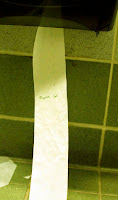
The work began as a single gesture of transferring flowers. Both the giver and the receiver are dead.
I take a set of flowers from an anonymous gravestone in a cemetery and move them to a neighboring grave.
Does the kindness of the action outweighs the criminal act? How would I explain the exchange to someone who saw me? I am giving a gift to the neglected, those who don't receive flowers on their birthday. I am giving them flowers so that they can be acknowledged.
Flowers are a strange gift. They have a short life span and withering within a few days. They mark the importance of a significant ephemeral moment. By giving flowers to the dead there is a hope that an events such as a holiday or anniversary is still important for the deceased. The kindness of the gesture out weighs the absurdity of it. The dead are unaware of the gift and the flowers are thrown away by maintenance. I am not trying to dismiss the gift by any means, I am participating in it. Though through its oddity we can examine our social relationship with the dead.
Gifts often create an exchange of power and responsibility, unconsciously we expect something in return for our generosity. A gift to dead is a one sided exchange, it lacks the ability for reciprocation. It is rewarding to give something to a loved one even if they are unaware it. A gift to dead is mirror like, with no visible appreciation from the receiver, we feel self fulfillment for our giving.
The flowers at the cemetery are diverse and beautiful. Do they have a specific significance to the dead? Are they their favorite? The loved one's favorite? Or were they chosen randomly with little consideration?
In my flower exchange, is there a preexisting relationship between the giver and receiver? If they have the same last name they are usually spouses or a family members, but otherwise there is no simple way determining a connection. It is easy to assume they are complete strangers. These strangers are part of a community that they will spend more time with than the living. The flowers become a housewarming present.
When I started to visit Forest Lawn for this project I was struck by the beauty of the space. A massive park filled with trees, public sculptures, and churches. It's so strangely manicured and clean. You can see sprinklers coming on all day to water the fields of grass. There is construction work occurring daily. Lawns are being mowed. Graves are being dug. I find the juxtaposition of family member crying and power saws quiet awkward and yet it is still peaceful. Everyone drives slowly in their cars and is very respectful of other drivers. In a city filled with so many unused parks, people come to cemetery and sit on the grass for hours with their loved ones. I see families on Saturdays with their umbrellas and picnic baskets eating lunch. People use the cemetery to jog and bike ride. The park becomes a complex constructed utopia. Perhaps the perfect place that you would want your loved ones to be buried? I don't know.
graves

.jpe)








